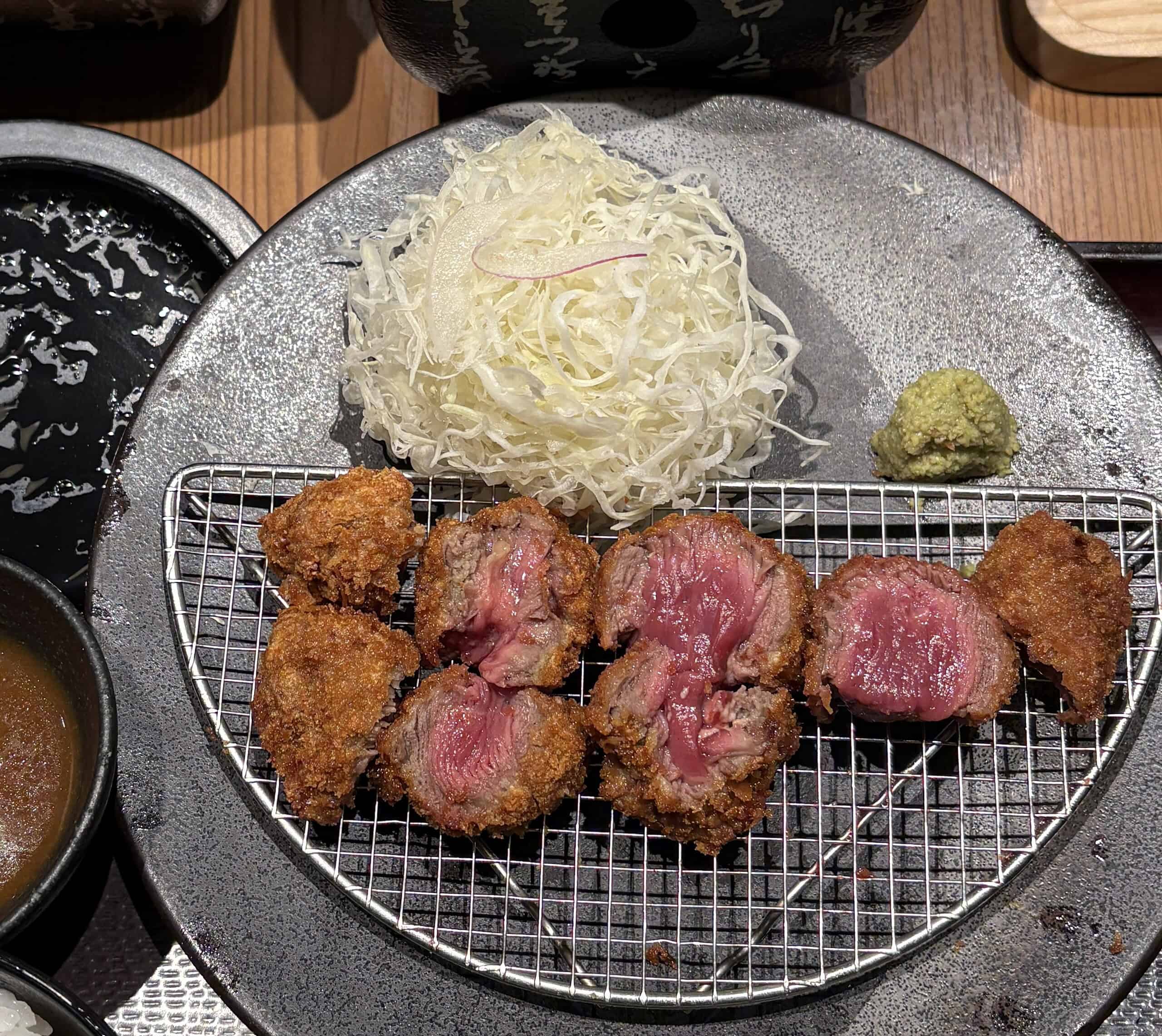Where to Eat Gyukatsu in Japan: Crispy Beef Cutlet
Gyukatsu is one of those Japanese dishes that takes something familiar, the idea of a breaded, fried cutlet, and elevates it into something unforgettable.
This crispy, golden beef cutlet is seared on the outside, tender and pink in the center, and served with multiple sides that makes it feel special every time you eat it.
Before visiting Japan, I had never tried Gyukatsu. I mean, I’d had Japanese BBQ like yakiniku plenty of times, loved curry katsu, and of course, enjoyed tempura.
But Gyukatsu wasn’t a dish I came across until I started planning my first trip to Japan. After some deep dives into Japanese food online, I discovered it, and immediately added trying Gyukatsu in Japan to the top of my must-eat list.
Now, it’s one of those meals I make a point of having a few times every time I visit. Let’s get into it, here’s everything you need to know about this amazing dish and where to eat the best Gyukatsu in Japan.
What Is Gyukatsu?
Gyukatsu (牛カツ) is a Japanese beef cutlet that’s breaded in panko crumbs, lightly fried, and typically served rare or medium-rare.
The contrast is what makes it special, crispy and golden on the outside, juicy and tender pink in the middle.
It’s usually served sliced into strips alongside shredded cabbage, rice, miso soup, and a dipping sauce or two.
In many spots, you’ll also get a small personal hot stone grill to lightly cook your slices to your preferred doneness.
The result is a meal that feels both comforting and interactive. You’re not just eating gyukatsu, you’re customizing each bite.
It’s hearty, flavorful, and surprisingly delicate all at once. This dish really is a palate explosion.
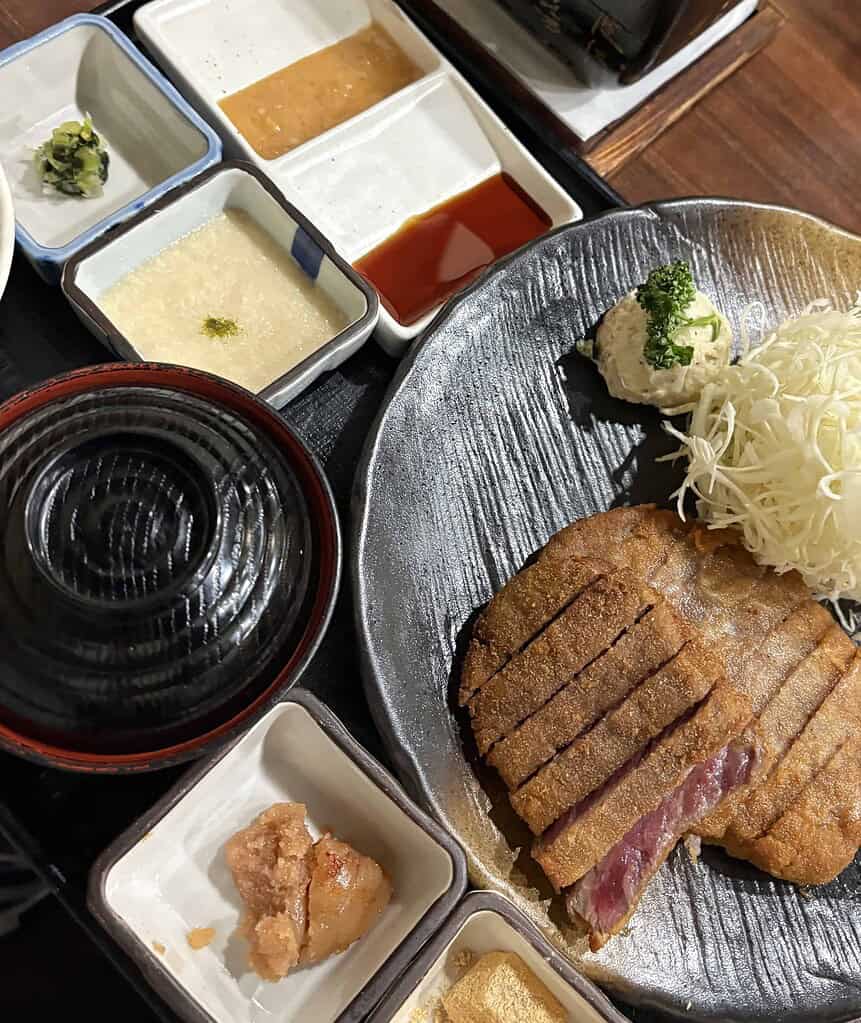
What Makes Gyukatsu Different from Tonkatsu?
While Tonkatsu is made with pork, Gyukatsu uses beef, and that makes all the difference.
The flavors are deeper, the texture is juicier, and the dish is usually served rare, letting diners cook it to their liking.
For those familiar with Tonkatsu, Gyukatsu offers a richer, more interactive experience.
It’s not just the meat that sets it apart, it’s also the DIY aspect, where you sear your own slices on a personal hot stone, customizing each bite to your preferred doneness.
How Gyukatsu Is Served
When you order gyukatsu in Japan, it’s rarely just the beef cutlet alone — and that’s part of what makes the experience so satisfying.
Some offer multiple portion sizes to choose from, while others let you select from different beef cuts, including more marbled or lean options.
And at premium gyukatsu spots, you might even find wagyu gyukatsu on the menu, a luxurious twist that melts in your mouth.
These higher-end places often allow you to choose the grade of wagyu, the cut, and the portion size to suit your appetite and budget.
A typical gyukatsu set (also called a teishoku) includes a few key components:
- Beef cutlet: Lightly breaded and fried to a perfect golden crisp, often served slightly rare in the center so you can finish cooking it on your personal hot stone grill.
- Hot stone grill: A small heated stone plate provided with your meal so you can sear the beef slices to your preferred doneness — a fun and interactive part of the experience.
- Cabbage salad: A mound of finely shredded cabbage, usually served with a light sesame or citrus-based dressing that cuts through the richness of the meat.
- Steamed rice: Often served in generous portions, sometimes mixed with barley (mugi gohan) for extra bite.
- Miso soup: A warm, umami-rich miso soup that will only elevate a few of those gyukatsu bites.
- Condiments: Expect an array of dipping sauces, soy-based tare, wasabi, rock salt, and sometimes even a mild curry sauce or raw egg, all enhancing the beef in different ways.
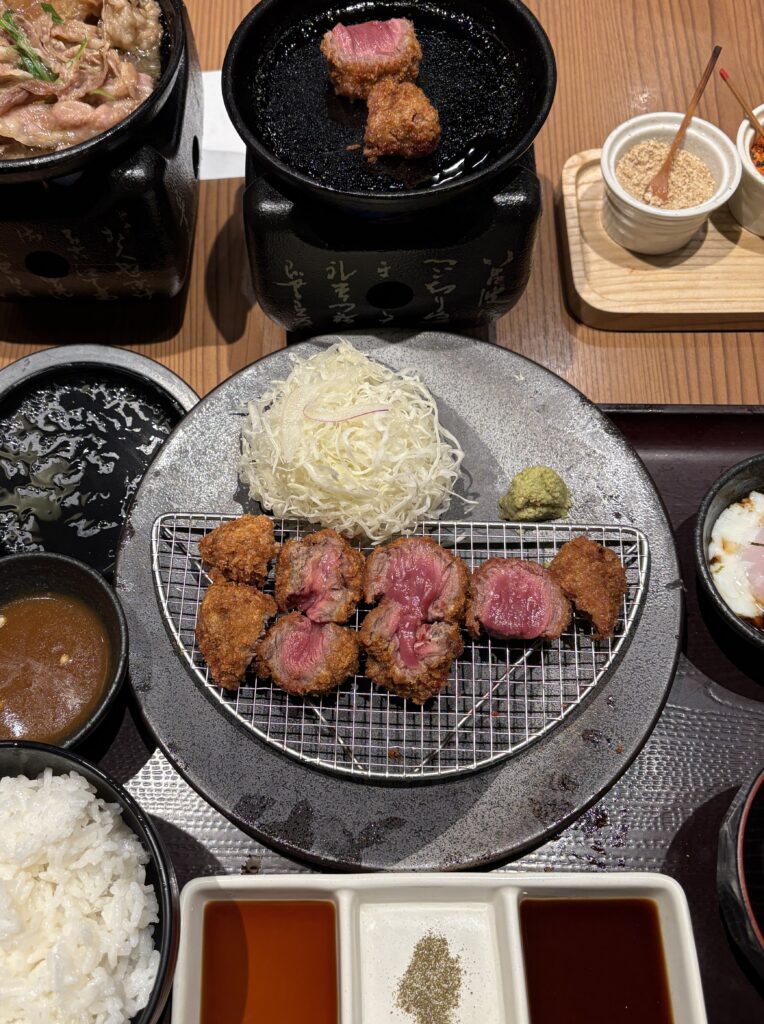
Best Places to Eat Gyukatsu in Japan
Whether you’re in Tokyo, Osaka, or Kyoto, Gyukatsu has become a staple on the Japanese food scene, and for good reason.
From famous chains to local favorites, you’ll find spots across the country serving up sizzling plates of this crispy beef cutlet. Here are some of the best places to try it during your Japan itinerary!
With its cult following, Gyukatsu is easy to find across Japan, especially in busy areas like Shibuya, Shinjuku, Namba, and Gion.
Just keep in mind: the more popular the spot, the more likely you’ll be waiting in line.
Tokyo
- Gyukatsu Motomura (Shibuya, Shinjuku, etc.): The most famous spot with tender cuts, sizzling mini grills, and long lines that move fast.
- Gyukatsu Ichi Ni San (Akihabara): Less touristy than Motomura but still delivers in taste. Known for its variety of dipping sauces.
Osaka
- Gyukatsu Kyoto Katsugyu (Namba): Sleek and modern with options for wagyu, curry sets, and generous portions.
- Gyukatsu Tomita: A local favorite in Osaka known for thick, juicy cuts and quick service. It’s a great no-frills spot for a satisfying Gyukatsu fix without long waits.
Kyoto
- Gyukatsu Kyoto Katsugyu: A popular spot in Kyoto serving consistently excellent Wagyu Gyukatsu with fast service and several set options to choose from.
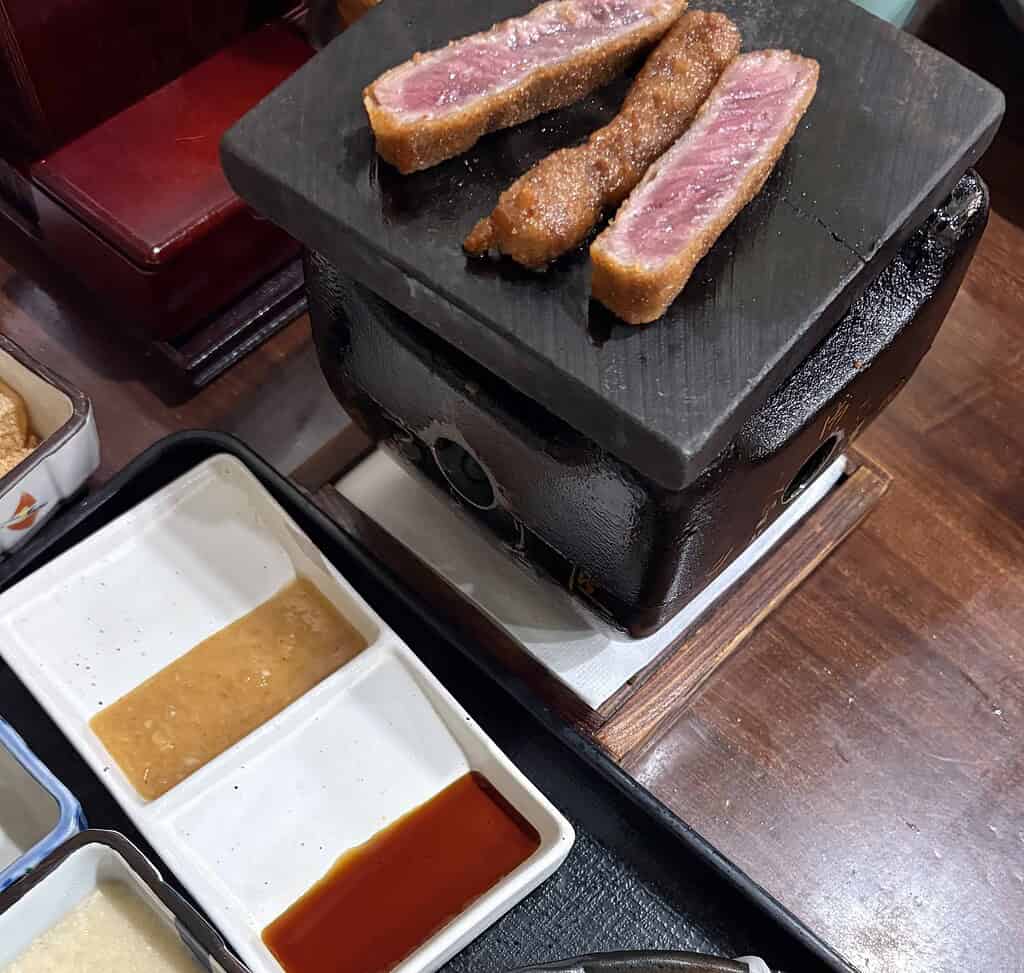
Tips for First-Timers Trying Gyukatsu
- Cook to your liking — but don’t overdo it: The beef is served rare, and you’ll sear it yourself on a small hot stone grill. Just a few seconds per side is all it takes. Leave it too long and the crust can burn, leaving a bitter aftertaste that takes away from the tender, flavorful beef.
- Try all the condiments: You’ll usually get a selection like wasabi soy, mountain salt, or house-made sauces. Try them all, each bite hits differently.
- Don’t be shy with staff: If your grilling stone gets too greasy or burnt, just ask for a replacement. Most places will happily bring you a fresh one.
- Add-ons are worth it: If the menu offers Gyukatsu with Japanese curry or a raw egg yolk on the side, get it. Just trust me on this one.
- Set menus are the way to go: You’ll typically get rice, miso soup, shredded cabbage, and sometimes pickles. It’s a more balanced and satisfying meal than ordering à la carte.
- Smaller portions go a long way: Gyukatsu is rich. Unless you’re starving, the smaller size is usually more than enough, especially if you’re food-hopping eating many meals in a day when you’re in Japan, like myself.
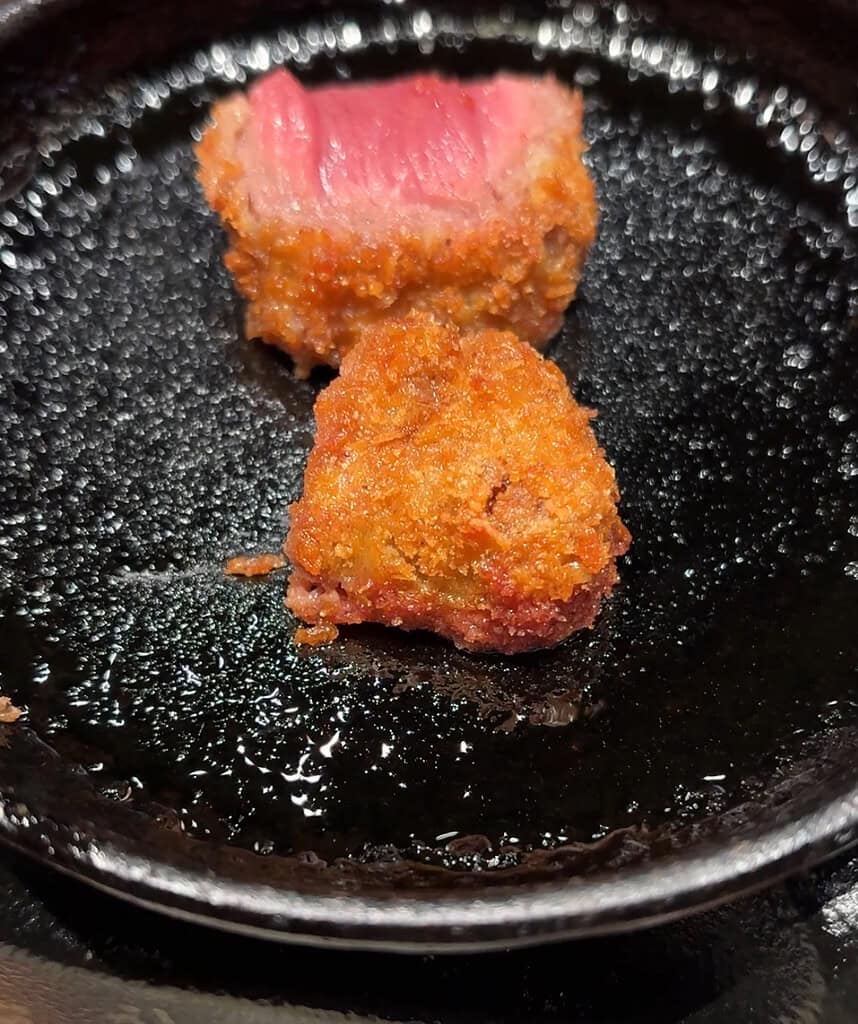
Final Thoughts on Gyukatsu in Japan
Gyukatsu is one of those Japanese dishes that leaves a lasting impression. It’s crispy, juicy, interactive, and packed with flavor, everything you want from a memorable meal.
Whether you’re eating it for the first time or looking to try another Gyukatsu restaurant in Tokyo, Osaka, or Kyoto, it’s an experience as fun as it is delicious.
Depending on where you’re visiting from, chances are you won’t easily find Gyukatsu back home, so do make the effort to try it while you’re in Japan. Trust me.
I absolutely love this dish. I’m someone who really appreciates when food hits you with layers, where every bite has you asking, “Wait, what’s that?”
That’s when cuisine becomes an experience. And that’s exactly what Gyukatsu is. Between the sauces, sides, and how you grill it yourself, the variety of flavors and textures keeps every bite exciting.
This dish is an absolute must-try in Japan. And while you’re at it, I also highly recommend trying a proper Japanese curry katsu, a different dish entirely, but another standout in Japan’s fried breaded cuisines.
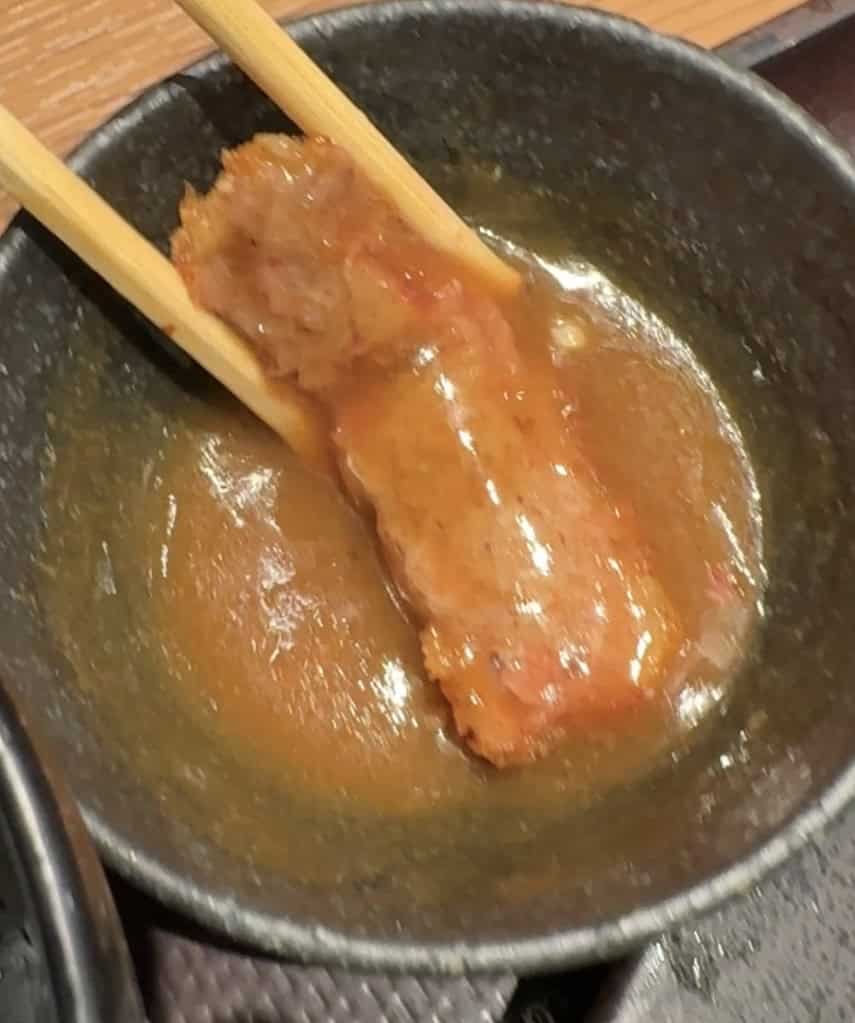
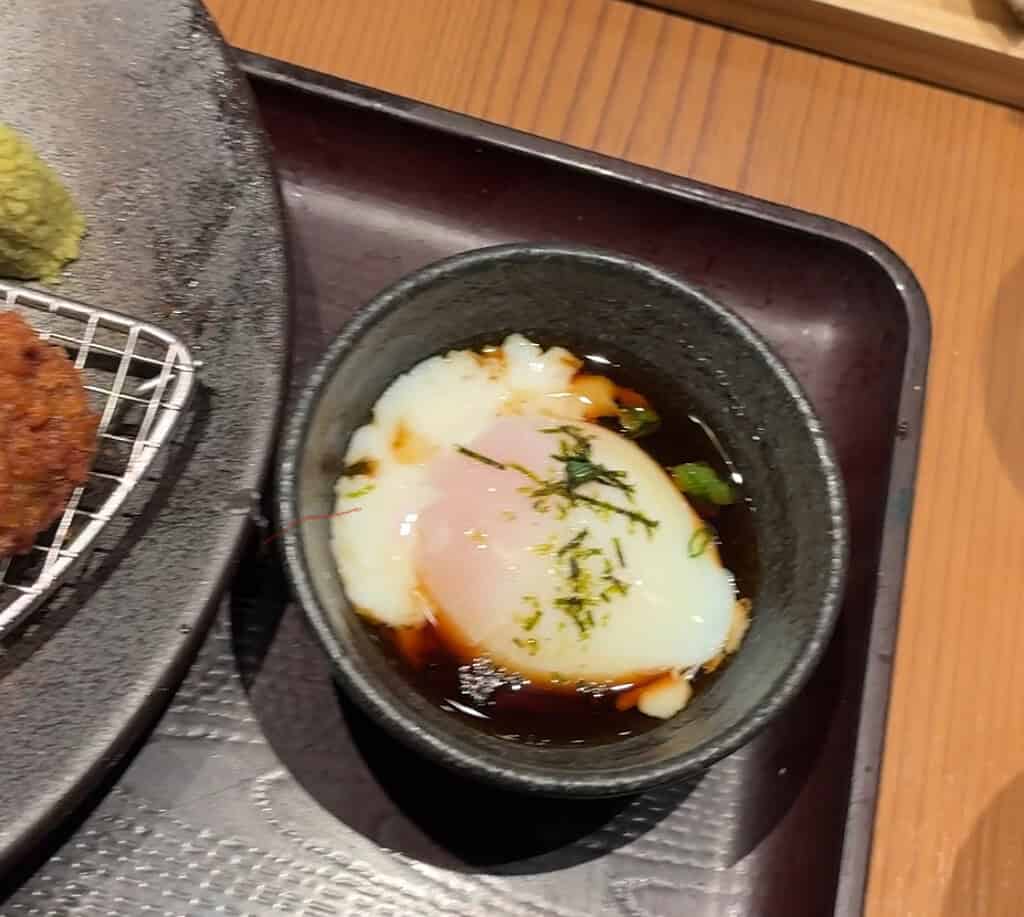
1What is Gyukatsu made of?
Gyukatsu is made from beef, usually sirloin or tenderloin, that’s breaded in panko and quickly deep-fried to create a crispy outer layer while keeping the inside rare. It’s typically served with rice, shredded cabbage, dipping sauces, and a hot stone grill to finish cooking the meat to your preference.
Is Gyukatsu raw inside?
Yes, that’s intentional. Gyukatsu is served rare on the inside, allowing diners to sear it to their liking on the provided hot stone. This helps maintain the juiciness of the beef and lets you control how well done you want each bite.
Where can I try Gyukatsu in Japan?
You’ll find Gyukatsu restaurants in major cities like Tokyo, Osaka, and Kyoto, especially in busy areas like Shibuya, Shinjuku, and Dotonbori. Look out for popular chains like Gyukatsu Motomura or regional favorites like Gyukatsu Tomita.
Is Gyukatsu spicy or suitable for all palates?
Gyukatsu is not spicy by default and is very approachable in flavor. It’s typically served with mild sauces like soy, wasabi, or grated daikon, and sometimes curry or raw egg on the side. It’s a dish that suits most palates, including first-time visitors to Japan.

